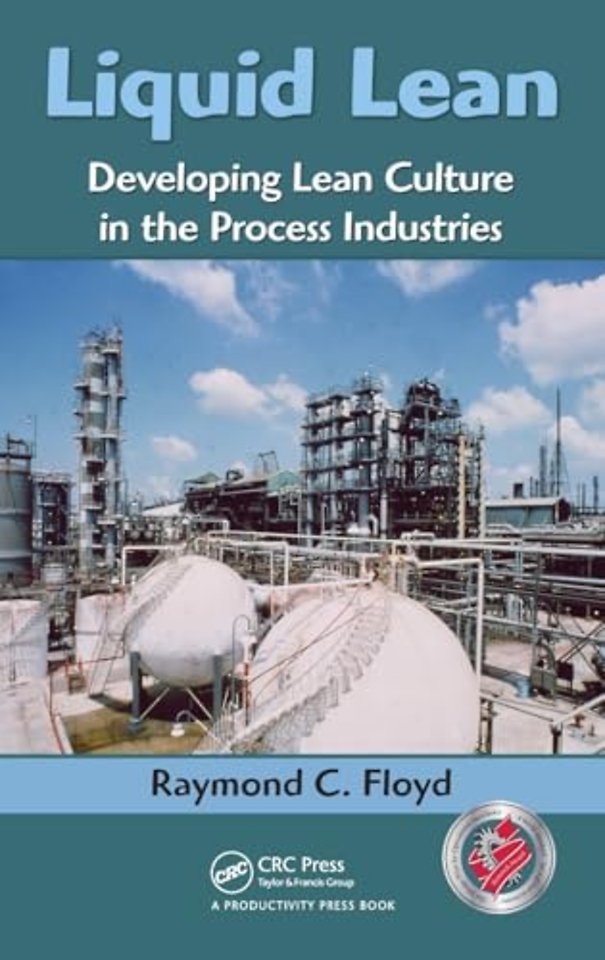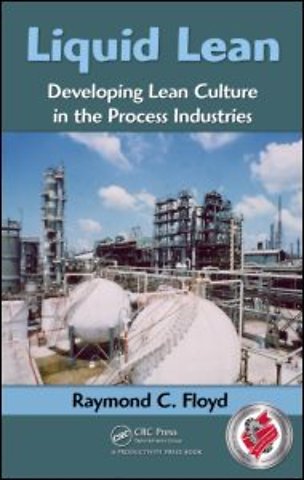Liquid Lean
Developing Lean Culture in the Process Industries
Gebonden Engels 2010 1e druk 9781420088625Samenvatting
While Lean practices have been successfully implemented into the process industry with excellent results for over 20 years (including the author’s own award winning example at Exxon Chemical), that industry has been especially slow in adopting Lean. Part of the problem is that the process industry needs its own version of Lean. The larger part of the problem is resistance to transformational change, a barrier that can only be overcome with effective leadership and results-oriented planning that engages rather than excludes all stakeholders.
Winner of a 2012 Shingo Prize!
Written by Raymond Floyd, an unparalleled leader of Lean transformations, Liquid Lean: Developing Lean Culture in the Process Industries provides potential process industry change agents with the no-nonsense guide needed to eliminate waste and achieve sustainable optimal efficiency.
Presenting lessons in lean as they apply within the liquid industries, the book focuses on developing the four measures of Lean as defined by the Shingo Award:
- Business Results
- Consistent Lean Enterprise Culture
- Continuous Process Improvement
- Cultural Enablers
Illustrated with his own success stories, Floyd describes business results, Lean enterprise thinking, and policy deployment in process industry terms. He offers detailed theory, practice, and examples of continuous process improvement, and describes the leadership and defines the ethics needed to evolve and sustain Lean transformation. Floyd lays out the specific steps needed during the first six months of transformation and the benchmarks to be achieved during the first two years of implementation. All companies can benefit from Lean; this book makes sure that those who want it, know how.
Specificaties
Lezersrecensies
Inhoudsopgave
Introduction
How This Book Is Organized: Shingo Prize Criteria
Business Results: Improve Performance with Lean
Beat the Competition with Very Flexible Manufacturing
Improve Performance with Lean and an Engaged Workforce
Gain First Mover Advantage
Achieve Prompt Improvement
All Companies Can Benefit from Lean, but Not All Do
Disruptive Changes
Why the Process Industry Needs Its Own Version of Lean
Transforming the Raw Material
Indirect Material Transformations
Time as an Independent Element of Production
Special Case: Continuous Processing
Notes
Chapter 2 Lean Enterprise Thinking
Introduction
Developing a Western Lean-Enabling Culture
Historical Perspective
Early View of Lean: Just-in-Time Manufacturing
Early View of Engaged Employees: Quality Circles
The Eight Sources of Waste
The Relationship between Inventory and Operating Problems
Value Streams and Support Processes
Lean Values: Inventory Reductions Can Sustain Improvements
Lean Values: Culture of Engagement
Notes
Chapter 3 Policy Deployment
Introduction
Large Events and Small Events
A Strategic View of Manufacturing
Strategic Alignment and Necessary Boundaries
Prerequisites for Structured Autonomous Improvement
Strategic Direction
The Role of Communication in Achieving Strategic Alignment
Limiting Opportunities for Improvement
Deploying Strategic Intent
Simple Statement of the Goal
Prose Statement of Intended Future State
Prose Statement of Current Reality
Objective Measures of Progress
Interim Performance Targets
Formatting Goal Statement
Translating Strategic Intent throughout the Organization
Framework for Action
How Quality Stations Work
Display the Team Goals
Display What the Team Has Completed
Show the Work in Progress
Provide Interactive Space
Policy Deployment in Action: Conversations at a Quality Station
Internal Team Conversations
External Team Conversations
Chapter 4 Improving Flexibility and Availability in Mechanical Equipment
Introduction
Single Minute Exchange of Dies System
What We Can Learn from NASCAR..4
Translating NASCAR Success to Our Plants
Preparation
Teamwork
Equipment
How to Use the SMED Concept
The Five Key Components of SMED Practice
Separation of Activities
Modification of Rate-Limiting Internal Activities
Modification of the Work Team
Modification of the Equipment
Modify Equipment to Maximize Efficiency
Preparing for Events and Sustaining the Improvements
Outcome of Improvements
Chapter 5 Operational Planning to Improve ChemicalTransitions
Introduction
The Causes of Chemical Inflexibility
Chemical Contamination
Unintended Conversions
Fixed Sequence Variable Volume Production
The Concept: A Comprehensive Approach to the Production Cycle
What We Can Learn from the New York Subway System
The Four Components of FSVV Practice
Typical Operating Problems
Changes in Process Conditions
Additives and Modifiers
Changes in Reactive Chemicals
The Fixed Sequence
Establishing a Fixed Sequence
FSVV Inventory Policy
Days of Demand in Inventory
ABC Inventories
FSVV Inventory Policy
Wheels within Wheels
Variable Volume Scheduling
Continuous Improvement
Sustainability over Time
The “Exception” Problem
Chapter 6 Assessment and Improvement of Other Accumulations
Introduction
Structural Differences between Process Industries and Mechanical Manufacturing
Small Accumulations in Process Industries
Chapter 7 Statistical Quality Improvement
Introduction
The Power of Statistical Quality Combined with Lean Manufacturing
Statistical Methods in the Process Industries
Basic Statistical Concepts
Six Sigma
Process Improvement before Statistical Analysis
Process Improvement Using Statistical Analysis
Operational Improvement with Statistical Analysis
Statistical Models of Process Performance
Using Statistical Analysis: The Process Capability
Index
Capable Processes
Incapable Processes
Using SPC at the Frontline in a Process Plant
Using a Run Chart
When the Run Chart Says the Process Is Operating Normally
When the Run Chart Says the Process Is Producing an Unexpected Result
When the Run Chart Says the Process Is “Nearly Normal,” but Results Are Drifting Avoid the Waste of Excess Quality Notes
Chapter 8 Mistake Proofing or Poka-Yoke
Introduction
Mistakes Come in Two Parts
The Consequences of Mistakes
Mistake Proofing: Preventing Consequences
Mistake Proofing Is Common Knowledge
Warning Systems
Four Types of Warning Systems
Poka-Yoke Practice 1: Physical Separation
Poka-Yoke Practice 2: Visual Signals
Poka-Yoke Practice 3: Pattern Recognition
Poka-Yoke Practice 4: Simple Physical Devices and Other Minor Changes
Approaching Perfect Production
Chapter 9 Equipment Reliability and Operator Care
Introduction
Finding the Cause: Separating the Processes from the Equipment
The Role of Equipment Reliability in Lean Practice
Operator Care
The Fundamentals of Operator Care
Phase I: Basic Care
Keep the Equipment Clean
Keep the Equipment Cool
Keep the Equipment Lubricated
Phase II: Advanced Techniques
Define Your Goals
Change the Oil and the Filters
Pay Attention
Autonomous Maintenance as an Element in Improvement
Autonomous Actions
Chapter 10 Lean Leadership and Ethics: Creating an Engaged Workforce
Introduction
Improvement Experiences at the Frontline
The Structure of Employee Engagement
The Elements of Engagement
Clear Goals
Skills Necessary to Achieve the Goals
Time to Make Improvements
Access to the Resources That Cause Change
Framework for Action
Engage Frontline Teams
What to Do When Teams Do Not Engage
Refresh the Understanding of Small Event Improvement
The Subjective Elements of Engagement
Lack of Trust in Management
Disruption by Team Members
Intentional Disruption
Unintentional Disruption
Industrial Culture
Notes
Chapter 11People Development
Introduction
Impact of Competent People on Organizational Performance
Competence Defined
Basic Competence
Basic Competence Development
Superior Performance
Critical Positions
Finding the Right Management Tool
A Quick Description of Our Analysis
The Influence of Critical Positions on Improvement
Individual Contributors
Subject Matter Experts or Mentors
Leaders
Identifying Critical Roles in Your Organization
Common Misconceptions
Developing Highly Competent People
Beginning the Process
Prompt Improvement
Sustaining the Improvement
Chapter 12 Leadership: Initiating and Sustaining Lean Operations
Introduction
Transforming an Organization and Sustaining the Change
Sustaining Improvement
Process Documentation
The Role of Transformational Leadership
Sustaining Leadership
When the Leader Is Not the CEO
Getting Started
The Value of 6-Month Intervals
Three Attributes of a Successful Beginning
The Value of Shared Vision
The Value of Immediate Pilot Projects
The Value of New Tools
Notes
Index
About the Author
Anderen die dit boek kochten, kochten ook
Rubrieken
- advisering
- algemeen management
- coaching en trainen
- communicatie en media
- economie
- financieel management
- inkoop en logistiek
- internet en social media
- it-management / ict
- juridisch
- leiderschap
- marketing
- mens en maatschappij
- non-profit
- ondernemen
- organisatiekunde
- personal finance
- personeelsmanagement
- persoonlijke effectiviteit
- projectmanagement
- psychologie
- reclame en verkoop
- strategisch management
- verandermanagement
- werk en loopbaan







